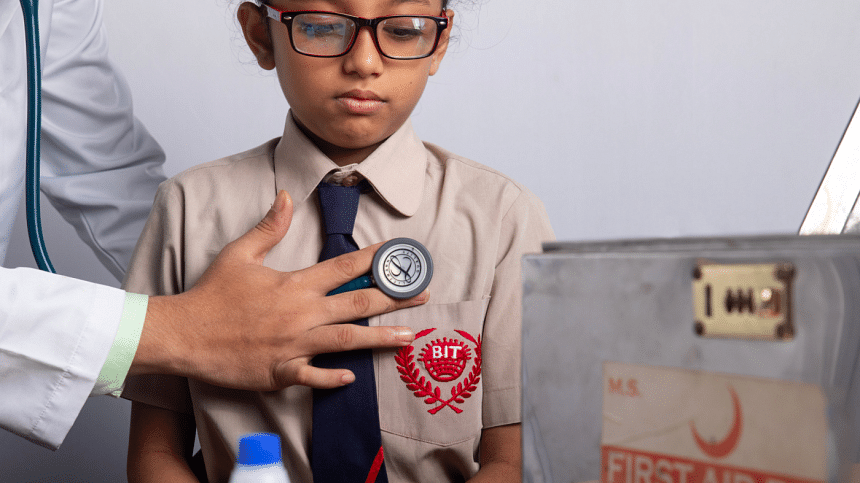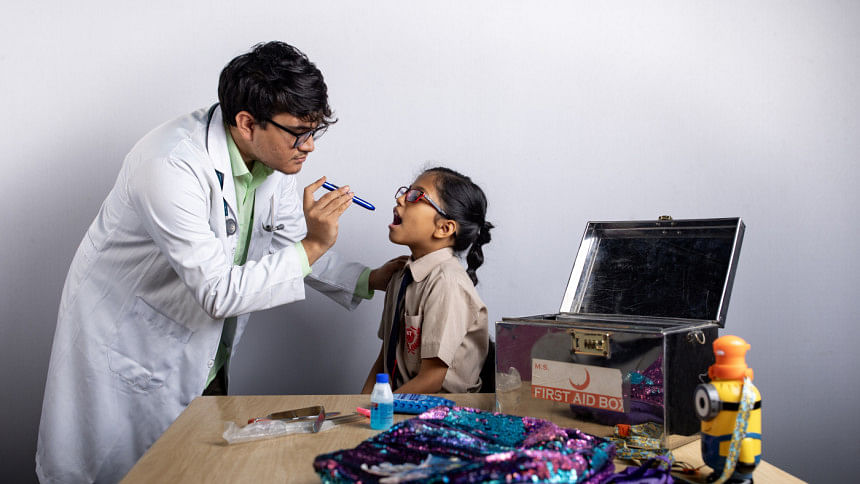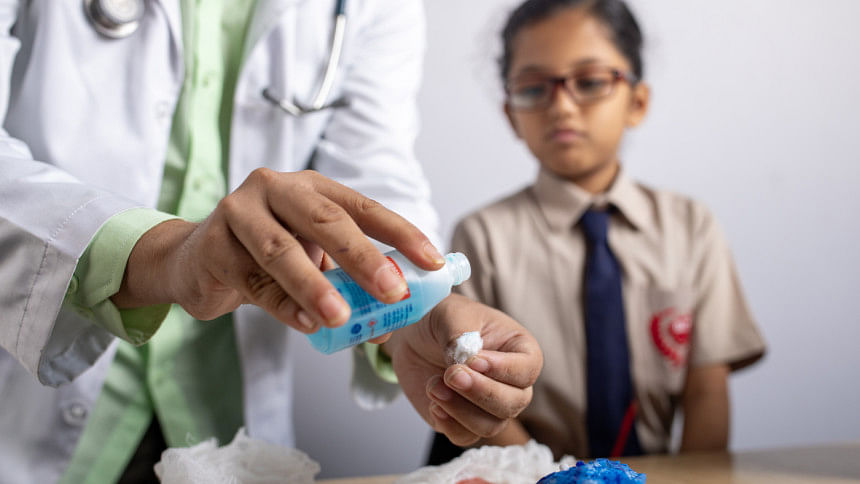Are schools ensuring adequate medical safety for their students?

In our pursuit of education, we spend a vast amount of our time at our school campuses. The activities of an average school day last somewhere between five to six hours. During that time, we remain under the supervision of our teachers and school staff, away from our homes. Beyond academics, schools play a vital role in ensuring and shaping our overall well-being. Given the time students spend at their institutions, schools must be equipped with the necessary means to tend to a student's health and medical needs, especially during emergencies.
This brings us to the question of how well our schools are doing on that end. The answer to that may depend on the socio-economic status of the school. Schools in affluent areas often have more resources; however, more resources do not always translate to better emergency responses.
"We have a sick room in our college. There are three beds and a first-aid kit, as well as a staff member who provides first-aid care related to cuts and bruises. The sick room usually has access to over-the-counter medicines that the staff hands out in case of gastric-induced pain or fever, that's mostly all. There doesn't seem to be any protocol present for emergencies," says Mahrush Zaman, a first-year student at Notre Dame College.
Even for schools that have a protocol for emergencies, the application may not be as efficient as it ought to be.
"In my school, the students are given a notice with an acknowledgement slip asking the parents to specify which hospital they want their child to be taken to, in case of an emergency. The school provides a few options, like Square, Evercare, and Kurmitola, along with any other hospital preferred by the parents, and asks the parents to choose an option. However, in case of an emergency, the school must take the child to the nearest hospital so that they can get in touch with a medical professional as quickly as possible. The current emergency protocol in-place contains layers of obstacles in terms of searching through the student's files to look for their hospital of choice and then acting accordingly," says Nirjhora*, a former student from a renowned English medium school in Dhaka and a second-year student at North South University (NSU).
By extension, the situation is more difficult for schools outside Dhaka, as a lack of proper infrastructure and resources prevents them from managing medical emergencies.
"There are no medical facilities or nurses to help us in case of an emergency in our college. The distance from our college to the nearest hospital is less than a kilometre, but we don't have any transportation available for emergencies either. While there are basic facilities for physical health issues, students can't get the immediate help they need during emergencies. I also believe that we should have at least some means of transportation ready in case an emergency arises," says Asif Jaman Jishan, a student of Ishwardi Government College, Pabna.
As we reached out to more people, the differences between their experiences started to wither away.
"There's no designated medical facility in our school, so we have to go to our teachers for medical assistance. The government hospital is the closest one to the school, but there is no designated vehicle for emergencies. As it is the teachers who provide first aid here, there's no paperwork involved when availing medical facilities. We have a vacant room in our school which may be repurposed to accommodate a nurse and supplied with first aid kits, medicine, and sanitary napkins," explains Syeda Sumaiya Orin, an eighth grader from Narail Govt Girls High School.

Some schools in urban areas do take care to ensure an efficient response to medical emergencies. These institutions, however, tend to be reserved for students whose families belong higher up in the socio-economic status. Although these schools charge higher tuition fees, using available resources to implement proper medical response is a step in the right direction.
Fatima Sadri, an elementary school teacher at Scholastica Mirpur, elaborates on the medical facilities at her institution and the role she plays in it, "We have a trained nurse to perform checkups and oversee medical issues at school. Additionally, we have two staff members who help her. I teach very young kids, so I encounter health issues like small cuts or injuries, headaches, and fever. For such cases, we have a khala who escorts the student to the sick room where the nurse takes care of them."
"We have two separate sick rooms for boys and girls, and each room has two beds for the patients. As a teacher, I'm given a slip detailing the health issues and subsequent treatment, which I sign and hand over to the student's guardians. The nurses also have access to students' information so they can contact the parents immediately in cases of emergencies," she adds.
Fatima goes on to say that her school's medical staff do not stock any medicines or painkillers, which is something she believes they can improve upon. However, she did mention that the medical staff does not want to prescribe anything without the consultation of a doctor, which is sensible given the intricacies of prescribing medicine. Yet, it serves as a reminder of the necessity of a trained professional on campus.
Young children are injury-prone, and older students from science streams are often exposed to risky environments while conducting laboratory experiments. Not to mention, children with disabilities, or those with pre-existing illnesses may need medical attention at a moment's notice. Schools should, at the very least, be prepared to respond to such scenarios by providing instant transportation to the nearest medical institutions.
Even outside of emergencies, students who suffer from chronic illnesses don't fare well without proper medical facilities. Bornil Murchhona, a student of class nine at Scholastica, has shared their experience manoeuvring school life as someone who suffers from conditions of nerves, migraines, bones, and respiratory issues.
"Schools are often prepared to deal with long absences or variable attendance backed by medical papers, but when they have to deal with a student who requires certain extra amenities, they become lost. One of the biggest roadblocks is bureaucracy. The submission and compilation of notes and papers, signatures and dated prescriptions add up. It is an unreasonable amount of documentation that must be done in writing, by the student and their family. This is a difficult task to manage on top of school responsibilities," Bornil remarks.
The infrastructures that are available in most schools aren't feasible for students who suffer from motor function loss like Bornil, who explains, "As an O level student in the Humanities, I have to go through long-winded, complex routes of applications at both my school and the British Council. I had to keep an application with myself even for taking the elevator too frequently. I also had to explain my health issues to individual teachers and guards constantly due to a lack of communication regarding these accommodations. Although I have been lucky enough to have the support of parents and the ability to visit a doctor semi-regularly, schoolwork still becomes difficult to balance on most days."
Bornil also mentions how there's a certain stigma attached to constantly asking for help due to health reasons, which serves as a deterrent for students who are already suffering.
Given the current situation, it appears that allocating adequate funds to accommodate proper medical facilities is somewhat of an afterthought across most institutions in the country. Yet, it needs to be a priority. To start off, sanitary napkins and first-aid should be free for all students. Additionally, the government must take steps to fund medical facilities in public schools both in urban and rural areas, and private institutions should have sanctions for the same reason.

Dr Jannatul Naima, a medical officer (ICU) at Long Life Hospital Ltd, shares her viewpoint on the minimum facilities schools must maintain, "Schools must ensure isolation for students with contagious diseases like flu and chickenpox, and also educate students on prevention and cure. The moment a student shows signs of a contagious disease, schools need to allow them a hiatus."
"In my opinion, every school should have a medical section, and they should host weekly awareness campaigns. They should teach the children basic hygiene like washing hands, sneezing etiquette, using masks, and recognising symptoms as well as providing a safe space for them to ask for help. Menstrual hygiene and awareness should also be emphasised, and the use of sanitary napkins should be taught. A monthly vaccination campaign, paid or non-paid, should also be hosted for diseases like Hepatitis B, influenza, chickenpox, tetanus, etc. An emergency corner should always be accessible for students who may contract injuries or face headaches and stomachaches."
Medical emergencies are not to be taken lightly by educational institutions, as they assume temporary guardianship of students during school hours. A proper medical facility is not only a necessity but serves to benefit every student, teacher, parent, and staff. As we reform our curriculum and institutions, it's pivotal that we also include the facilitation of emergency medical care.
*Name has been changed upon request.
Fahad and Zabin like the idea of frog hats and medical safety for all. Find them at: [email protected] and [email protected] respectively.

 For all latest news, follow The Daily Star's Google News channel.
For all latest news, follow The Daily Star's Google News channel. 










Comments